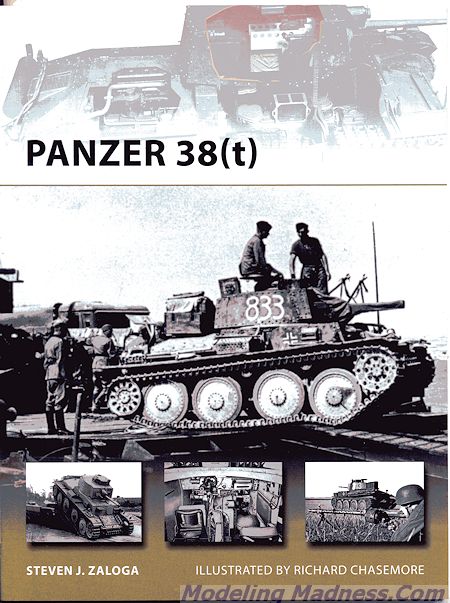 One
of my favorite series of books from Osprey Publishing is the New Vanguard
series. These are equipment books that cover a variety of subject at a level
that doesn't go into minutiae so that those who want to know more can always go
to the larger (and much more expensive) enthusiast publications.
One
of my favorite series of books from Osprey Publishing is the New Vanguard
series. These are equipment books that cover a variety of subject at a level
that doesn't go into minutiae so that those who want to know more can always go
to the larger (and much more expensive) enthusiast publications.
This particular one is on one of the most successful German light tanks
of the early war. What's more, it was not a German design, but a Czech offering.
Basically, these guys just got it all right and produced a tank in the late 1930
which, for the time, provided the right combination of firepower, speed and
protection.
At a time when other nation's light tanks were armed with machine guns
or small canon, the Panzer 38(t) had a 37mm gun that was able to penetrate the
armor of all its opposition. It also had a different suspension that looks
similar to a Christie suspension, but was not and was simple to maintain and
helped provide the relatively good speed of the tank.
Where it differed from German tanks is that it had a two man turret vice
having room for three. This meant that the tank commander was also the gunner,
requiring extra work from him. However, it was used in quite large numbers
during the first year of the war. The Germans were able to get the tank thanks
to their invasion of Czechoslovakia in the year prior to the war, making Czech
military equipment of all sorts available to the German military.
The tank was also used up to and including the invasion of the Soviet
Union, but by that time it was obsolescent and unable to stand up to the Soviet
T-34, despite improvements to the design that included double the thickness of
armor. However, it was still useful as a reconnaissance tank and for use in
anti-partisan operations where they would not have to face bigger tanks. The
chassis was also most useful for other types of AFV such as the Marder III SPG
and the Hetzer. The tank saw limited use post war, but was still in some
nation's inventories in the late 1950s.
As usual, this series provides a look at the background that led up to
the tank, its use in the armies of other nations and its use during various
battles of the war. This is accompanied by excellent period photos as well as
equally fine art-work that includes a cut-away of the tank. In all, it
makes for an excellent book on the subject and one that needs to be on the shelf
of any armor modeler and enthusiast.
November 2014
For more on the complete line of Osprey books,
visit http://ospreygrp.com. In the US, it is
Osprey Direct at 44-02 23rd St, Suite 219, Long Island City, NY 11101., where you can
get a catalogue of available books.
If you would like your product reviewed fairly and
fairly quickly, please
contact
the editor or see other details in the
Note to
Contributors.
 One
of my favorite series of books from Osprey Publishing is the New Vanguard
series. These are equipment books that cover a variety of subject at a level
that doesn't go into minutiae so that those who want to know more can always go
to the larger (and much more expensive) enthusiast publications.
One
of my favorite series of books from Osprey Publishing is the New Vanguard
series. These are equipment books that cover a variety of subject at a level
that doesn't go into minutiae so that those who want to know more can always go
to the larger (and much more expensive) enthusiast publications.